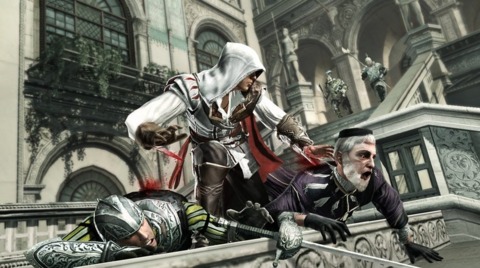Ubisoft on designing Assassin's Creed II
GDC 2010: Sequel designer discusses core gameplay pillars, mission repetitiveness, using play tests as a mirror.
Who was there: Patrick Plourde, lead game designer at Ubisoft and one of the key minds behind last year's hit sequel Assassin's Creed II.

What they talked about: While commercially successful, the original Assassin's Creed also had its fair share of detractors. For the sequel, Ubisoft focused on creating a greater variety of missions and objectives, with lead game designer Patrick Plourde using his session at GDC 2010 to outline the team's strategies for "answering every criticism of the first game."
Plourde began by outlining the challenge faced by the 300-strong team working on Assassin's Creed 2: create a game within a two-year time period with 230 features, with no revision time and be both commercially and critically acclaimed. With such high expectations, Plourde said the oft-used motto of "fail early, fail often" would simply not be an option with Assassin's Creed II. The strategy Plourde and the design team came up with was three-pronged: keep the design focused on the core of the game, have a strong documentation structure, and use testing data to validate game design.
The first strategy--having focused design--is all about deciding what type of game you're making, a decision that Plourde said every game development team needs to make at a very early point in the process. For Assassin's Creed II, Plourde said the gameplay pillars were fighting, navigation, and social stealth. "Your gameplay pillars need to be rock solid. If you're a shooter, your shooting needs to be fun. If your platforming is floaty, no one will care there's an amazing third level because no one is going to reach there," he said.
Plourde described the combat in Assassin's Creed II as being different from other games due to its basis in timing and counters, rather than combos. When it came to navigation, fluidity was the focus, with Plourde taking a stab at critics who previously said the free running in the series was too easy. He explained the team wanted to put the challenge in analyzing the environment to maintain fluid movement, as opposed to button presses. The final pillar--social stealth--was given a makeover from the first game, changing the mechanic so that crowds would become a positive thing for players rather than a hindrance.
Once the pillars were identified, the team then went about inserting those pillars in all aspects of gameplay. Plourde said while he agreed with some critics about the missions in the original Assassin's Creed being repetitive, it wasn't for the same reasons. "No one says Tetris is repetitive because blocks are always falling down. Instead, Assassin's Creed missions didn't use core gameplay. They were minigames. Sit on a bench and press Y, for example. They ended up being boring," he said. "If you use your core gameplay as [a] basis for your missions, they're more fun." He used the example of assassinations in the game--there was no core assassination-specific mechanic in Assassin's Creed 2. Instead, players had to use the three core gameplay elements of fight, navigation, and social stealth to succeed.
That doesn't mean you can't have other features within your game, Plourde said, just that they should have less polish than your core gameplay. He cited the example of the economy system in Assassin's Creed 2, saying that compared to something like EVE Online, it was actually quite poor. "But if it's treated as a reward, it becomes a positive in the player's mind," he said.
When it comes to play-testing, Plourde said the process can be a vital mirror into the state of a game. He cited two issues that testing identified; the first being that players tended not to use rooftops to get to objectives (unless they were required to by the mission). The development team then changed the animation of Ezio climbing, which meant he was able to scale buildings much more quickly.
The second issue was with the blend mechanism in the game. Initially, the game's designers planned for the B button to be held down in order to blend with crowds, but testing showed that most players simply didn't understand how the mechanic worked. Plourde and the team then decided to make blending automatic, which significantly increased usage and understanding of the mechanic in future play tests. Finally, Plourde revealed one issue they weren't able to fix--combat. Many play testers cited that the combat didn't feature enough variety, despite the many moves and abilities available in-game. There was no time to address this concern, Plourde said, adding that many reviews picked up on that issue in their critique.
Quote/Takeaway: "Understanding your game is the cornerstone of a successful production." -- Patrick Plourde, lead game designer at Ubisoft
Got a news tip or want to contact us directly? Email news@gamespot.com
Join the conversation